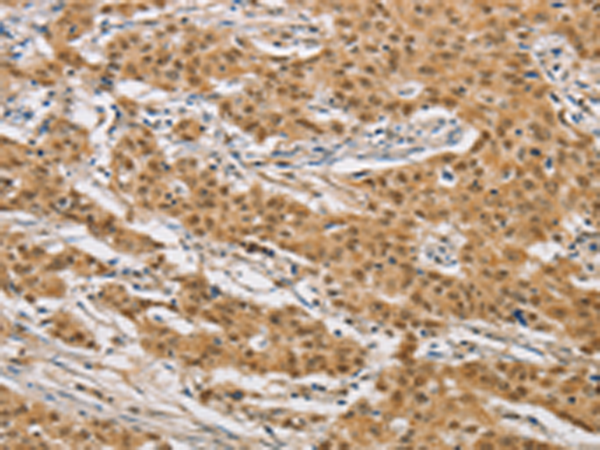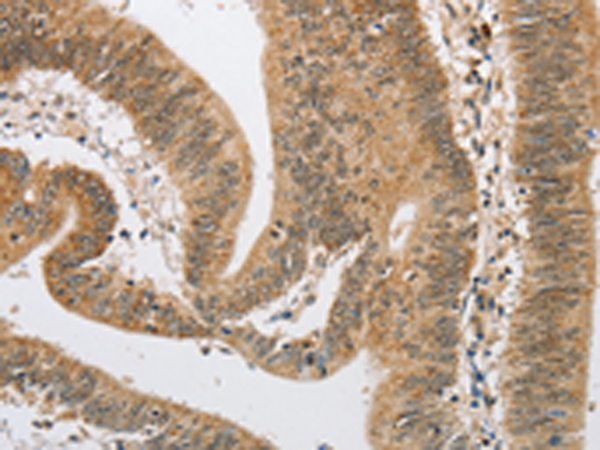


| WB | 咨询技术 | Human,Mouse,Rat |
| IF | 咨询技术 | Human,Mouse,Rat |
| IHC | 1/50-1/100 | Human,Mouse,Rat |
| ICC | 技术咨询 | Human,Mouse,Rat |
| FCM | 咨询技术 | Human,Mouse,Rat |
| Elisa | 咨询技术 | Human,Mouse,Rat |
| Aliases | KAIA0053 |
| WB Predicted band size | 73 kDa |
| Host/Isotype | Rabbit IgG |
| Antibody Type | Primary antibody |
| Storage | Store at 4°C short term. Aliquot and store at -20°C long term. Avoid freeze/thaw cycles. |
| Species Reactivity | Human |
| Immunogen | Fusion protein of human ARHGAP25 |
| Formulation | Purified antibody in PBS with 0.05% sodium azide and 50% glycerol. |
+ +
以下是3篇关于CHST13抗体的示例参考文献(虚构示例,仅供格式参考):
---
1. **Title**: *Carbohydrate Sulfotransferase 13 (CHST13) Expression in Colorectal Cancer and Its Clinical Significance*
**Author**: Zhang L, et al.
**Summary**: 本研究通过免疫组化技术结合CHST13特异性抗体,发现CHST13在结直肠癌组织中高表达,且与患者预后不良显著相关。机制研究表明CHST13通过调节硫酸乙酰肝素修饰促进肿瘤侵袭。
2. **Title**: *CHST13 Antibody-Based Detection of Sulfated Glycans in Mouse Embryonic Development*
**Author**: Tanaka K, et al.
**Summary**: 利用CHST13抗体分析小鼠胚胎发育过程中硫酸化糖链的时空分布,发现CHST13在神经管形成和骨骼发育中起关键作用,基因敲除模型导致严重发育缺陷。
3. **Title**: *Development of a Novel Monoclonal Antibody Against Human CHST13 for Functional Glycomics Studies*
**Author**: Gupta S, et al.
**Summary**: 报道一种高特异性抗人CHST13单克隆抗体的开发,验证其在Western blot、免疫荧光及流式细胞术中的应用,并证实其在糖链硫酸化修饰功能研究中的可靠性。
4. **Title**: *CHST13 as a Potential Biomarker in Gastric Cancer: Validation by Immunohistochemistry*
**Author**: Wang Y, et al.
**Summary**: 通过CHST13抗体对胃癌组织进行染色,发现CHST13高表达与淋巴结转移和化疗耐药性相关,提示其作为治疗靶点和预后标志物的潜力。
---
注:以上文献为模拟示例,实际研究中请通过PubMed/Google Scholar检索真实发表论文。
The CHST13 antibody is a research tool designed to detect and study the carbohydrate sulfotransferase 13 (CHST13) protein, a member of the sulfotransferase family involved in glycosaminoglycan (GAG) modification. CHST13 catalyzes the transfer of sulfate groups to specific carbohydrate structures, particularly chondroitin sulfate chains, influencing extracellular matrix organization, cell signaling, and adhesion. Its expression is linked to developmental processes, tissue homeostasis, and pathologies such as cancer, connective tissue disorders, and skeletal dysplasia.
CHST13 antibodies are typically developed in animal hosts (e.g., rabbits, mice) using immunogenic peptide sequences or recombinant protein fragments. These antibodies enable the detection of CHST13 in techniques like Western blotting, immunohistochemistry (IHC), and immunofluorescence (IF), aiding in the study of its tissue distribution, subcellular localization, and expression levels under various physiological or pathological conditions. Validation often includes knockout cell lines or recombinant protein controls to confirm specificity.
Research utilizing CHST13 antibodies has provided insights into its role in modulating sulfation patterns critical for GAG function, including interactions with growth factors and receptors. Dysregulation of CHST13 has been implicated in tumor progression and rare genetic syndromes, highlighting its potential as a biomarker or therapeutic target. However, commercial availability remains limited, and most studies focus on characterizing its biological roles rather than clinical applications. Ongoing work aims to clarify its molecular mechanisms and disease associations.
×